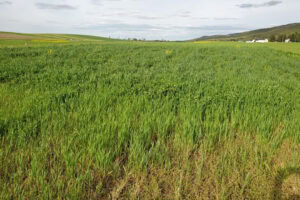Reducing nitrous oxide emissions from cover crops

Nitrous oxide emissions related to cover crops can be managed, according to Penn State researchers.
The application of manure after the growth and demise of legume cover crops in rotations is a recipe to increase nitrous oxide releases during ensuing corn growth, according to a team of Penn State researchers who conducted a new study. They suggest that innovative management strategies are needed to reduce these emissions.
Agriculture accounts for 80% of nitrous oxide emissions
Even small emissions of nitrous oxide affect the climate. The greenhouse gas nitrous oxide is 300 times better at trapping heat than is carbon dioxide. According to Armen Kemanian, professor of production systems and modeling in the College of Agricultural Sciences at Penn State, in the United States, agriculture accounts for approximately 10% of all greenhouse gas releases but contributes about 80% of all nitrous oxide emissions linked to human activity. “Of the three major greenhouse gases emitted naturally – carbon dioxide, methane and nitrous oxide – nitrous oxide is the most important in field crops.”
Also read: Measuring nitrogen in cover crops
Soil fertility in organic agriculture relies on microbial cycling of nutrient inputs from legume cover crops and animal manure. However, large quantities of carbon and nitrogen in these amendments may promote the production and emission of nitrous oxide from soils. The nitrogen in the decaying biomass from the cover crops, combined with the nitrogen in applied manure, is often too much for the soil to hold, said Debasish Saha, assistant professor of sustainable soil management, University of Tennessee.
Emissions measured in corn-soybean-winter grain rotations

The researchers measured soil nitrous oxide releases for two growing seasons in four corn-soybean-winter grain rotations, with tillage, cover crop and manure-management variations typical of organic agriculture in temperate and humid North America. They measured fluctuating emissions of nitrous oxide in microplots where they manipulated cover crops and manure additions. The researchers suggest that high levels of nitrous oxide emissions came after fast oxygen consumption in the soil resulting from the burial of cover crop residues and manure.
10 pounds per acre
The study shows the nitrogen input from legume cover crops and manure prior to corn planting made the corn phase of rotations the main source of nitrous oxide releases, with emissions averaging about 10 pounds per acre of nitrogen escaping as nitrous oxide. “That represents 80% of the three-year rotations’ total emissions. Emissions rose sharply when both legume and manure inputs increased simultaneously,” Kemanian said.
The researchers proposed several strategies to reduce those emissions. One is to remove a fraction of the legume aboveground biomass before corn planting. In the study, preventing the “co-location” of fresh biomass and manure decreased nitrous oxide emissions by 60% during the corn phase.
Join 17,000+ subscribers
Subscribe to our newsletter to stay updated about all the need-to-know content in the agricultural sector, two times a week.



